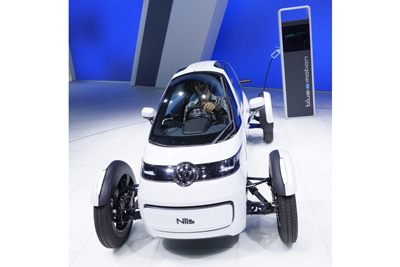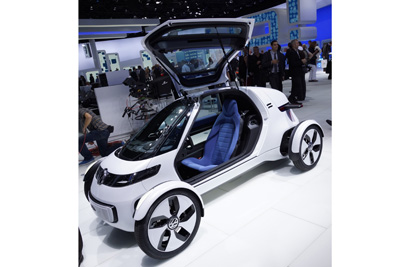Volkswagen NILS Research Vehicle Concept 2011
Volkswagen AG is presenting a car for the urban world of tomorrow at the 64th International Motor Show (IAA) in Frankfurt: NILS. The single-seat
electric vehicle reflects a new, fascinating form of minimalist
mobility. The concept car – with its progressive aluminium space
frame, wing doors and free-standing wheels – exhibits a high level of
dynamic performance, yet travels with zero emissions and silently
towards the future. The project is supported by the German Federal
Ministry of Transport, Building and Urban Development.
Technically realistic and economically feasible. “NILS is a vehicle
that anticipates the future. It looks as though someone had projected
it back from the year 2030 to the world of today. This study melds
sustainability, design and lifestyle in a new way. A high-tech vehicle
from the Volkswagen company with an electric drive, but very
realistically conceptualised,” says Dr. Ulrich Hackenberg, member
of the Board of Management and Head of Development for the
Volkswagen Brand."
Dr. Ulrich Hackenberg explains further: “The goal of
the NILS project is to work out a technically concrete and
economically feasible vehicle concept for micromobility, which
restructures individual transportation to make it more efficient and
environmentally compatible based on electric drive technology.”
Prof. Dr. Jürgen Leohold, Director of Volkswagen Group Research, says : “Therefore, Group Research
intensively analysed all facets of commuter transportation with the
goal of making it sustainable for the future. The results of these
analyses were made available to individual vehicle development
departments. And so, all of the company’s brands – from A for Audi
to V for Volkswagen – are benefiting from the think tank of Group
Research.”
With a range of 65 kilometres, the 130 km/h NILS would certainly
be the ideal vehicle for the majority of commuters in Germany.
According to the German Federal Statistical Office, 73.9 per cent of
all commuters residing between Berlin and Munich cover less than
25 kilometres on their way to work. So, NILS is designed to be a
reflection of a new era.
Electric traction changes mobility in Volkswagen Group. Many Volkswagen Group models in the higher vehicle classes
are already available with hybrid drives, where the electric motor
supports the conventional drive system. This emissions-reducing
drive technology is now breaking into high-volume segments.Golf with E-drive debuts in 2013. The first high-volume models
with a pure electric drive will soon reach production readiness; the
Golf, one of the best-selling car in the world, will debut with an electric
drive (Blue-e-Motion) in 2013.
The NILS concept is a very compact car that requires extremely little space in traffic. NILS is only 3.04 metres long, making it about 50 cm shorter than the new Volkswagen
up! The width of the NILS, from wheel to wheel, is 1.39 metres; the
body itself measures only 0.86 metres wide. The concept car is 1.2
metres tall. By means of comparison: a Porsche 911 is taller at 1.31
metres.
The NILS shares the same basic body layout as a Formula-1 race car body: driver in the middle,engine in back, aluminium wheels outboard and free-standing. The
17-inch alloy wheels are equipped with 115/80 (front) and 125/80
(rear) tyres optimised for low rolling resistance. The clean,
distinctive styling of the NILS car has its origins at the Volkswagen
Design Centre in Potsdam. Designer Thomas Ingenlath, the centre’s
director, comments on the research vehicle: “NILS was designed to
make a visual statement and transport a vision of the automotive
future to the present. The car had to visually highlight the theme of
sustainability, while showing a future-oriented look and simply
being fun. I think that we have successfully integrated both of these
aspects. Although our mission here was to come up with an entirely
new body concept for the brand, NILS matches the Volkswagen
design DNA 1:1.”
 |
 |
65 km and 130 km/h. Although, or even because, NILS is so
compact and lightweight (460 kg), it is a lot of fun to drive. It is an
agile car with a top speed of 130 km/h, and it can accelerate to
100 km/h in less than 11 seconds. This is accomplished by an
electric motor with a reasonably small 15 kW nominal power and
short-term peak power of 25 kW. A lithium-ion battery supplies the
electric motor with energy. The battery capacity (5.3 kWh) enables
driving ranges of up to 65 km, depending on the style of driving. A
battery of this size is relatively inexpensive, and its capacity is
sufficient for this type of car. The research vehicle can be charged
either via a conventional 230 Volt electrical outlet (maximum
charging time 2 hours) or at an electric vehicle charging station. The
plug port is located at the back underneath the rear lighting module.
Electric motor is a lightweight 19 kg. In setting up the electric
drive system, engineers made use of the great wealth of experience
Volkswagen has acquired in developing other concept cars such as
the L1 and XL1 as well as future production vehicles like a Golf
Blue-e-Motion or up! Blue-e-Motion. The centrepiece of the drive
unit is the lightweight 19 kg electric motor together with its
transmission and battery. Energy management is via a high-voltage
pulse inverter, which – together with the 12 Volt DC/DC converter
for the vehicle electrical system and the charger – forms an integral
drive unit. It is the rear axle that is driven. All drive unit components
are located compactly in an aluminium housing. The unit, including
the drive shafts, is integrated at the rear of NILS.
The electric motor produces a maximum torque of 130 Nm,
which is transferred to the rear axle via a one-speed transmission.
For wheel control and suspension, there are double-wishbone
suspensions front and rear; the ESP electronic stabilisation
programme ensures that with all of its agile performance, NILS will
still stay on course. The car’s good weight distribution between
the front and rear axles contributes towards the ESP having to do as
little as possible.
NILS brakes and accelerates automatically upon request
Innovative City Emergency Braking. Another important electronic
assistant in NILS is City Emergency Braking. The continually active
system uses a laser sensor (in the front VW logo) to detect the risk
of an imminent collision, and at that moment it automatically brakes
the car. Depending on the car’s speed and the driving situation, City
Emergency Braking can reduce the speed at impact and might even
prevent an accident.
Automatic Distance Control. City Emergency Braking is a software
extension of the automatic distance control system (ACC). Its full
range of functionality is available in NILS. The ACC system also
uses a laser sensor to measure the distance and relative speed to the
vehicle ahead in traffic – parameters to which NILS automatically
adjusts its speed.
Not only are the four disc brakes used to brake; electric
traction by electric motor and battery regeneration can be used to
brake as well, depending on the driving situation. Last but not least,
Front Assist is integrated in the ACC system. This continually active
system warns the driver of a potential collision; at speeds below 30
km/h, automatic braking can avoid a collision under some
circumstances.
TFT LCD (Thin Film Transistor - Liquid Crystal Display) as instrument cluster. The instrument cluster was
tailored to the electric vehicle. The main surface here is a 7-inch
TFT display. The vehicle’s speed is shown digitally in the middle.
Energy flow is visually represented by bar elements. Another graphic
display offers information on the driving range.
Clever touchscreen. The second central instrument is a mobile
multifunctional talent like the one used in a similar form in the new
up!: the Portable Infotainment Device (PID).
At the start of the drive, the PID computes the
expected driving range, then it not only displays the route on the
map display, but also the radius and thereby the destinations that can
be reached using the current battery charge.
Simple where it makes sense. To save on weight and costs, certain
functional elements and controls are operated without electrical
assistance. The side mirrors, for example, are adjusted manually,
which is not really an inconvenience in an interior that is only 0.61
metre wide. There is no power assistance for steering either;
however, this is no problem on a vehicle weighing less than 500 kg.
Located to the right of the steering column is the motor
start-stop switch; this round, handy switch is also used to select the
position of the single-speed transmission (D, N or R).
Safe like a big car. The aluminium space frame body was designed
to be a highly effective safety cell.
The 2 wing doors are a work of art in
their manufacture. Their frames consist of 3 main elements: an inner
section, a crash reinforcement section and an exterior part. When
they are closed, they offer optimal crash safety. The door windows
are made of lightweight, scratch-resistant, layered polycarbonate.
The front window is made of laminated safety glass.
See and be seen. Xenon and LED elements are used for the
headlights, rear lights and indicators. In front, 2 bi-xenon modules
handle the job of the dipped and main beam headlights. The indicator
lights and daytime running lights are implemented as white and
yellow LEDs. The daytime running lights are mounted on the front
wheel trim panels, and these lights also serve as position lights for
parking. In the acrylic glass of the rear lights – which are integrated
in the rear section like small wings – the light generated by LEDs is
routed via transparent semiconductors. Their electrical power
consumption? Minimal. Which is very apropos to electric vehicles.
photos Volkswagen Media Archive and NEWSPRESS
Wallpapers : Volkswagen NILS Research Vehicle Concept 2011